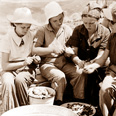
A. Members of Kibbutz Kfar Masaryk prepare for ceremony
Naaman factory: Settlement's building blocks
Cornerstone for foundation of one of kibbutz industry's first factories laid in 1939. Naaman brick factory supplied population's growing need for construction materials. Series of photos documents its establishment
The Shomer Hatzair movement's archive in Givat Haviva has an interesting photo collection documenting the establishment of one of the first factories of the kibbutz industry – the Naaman factory for the production of clay brick, which was built near the northern city of Akko.
In the 1930s, when the pioneers arrived in the Land of Israel and engaged in construction, the need arose for a factory manufacturing construction materials, particularly bricks.
One of the biggest initiators of the factory was a modest pioneer named Mordechai Shenhavi (1900, Ukraine-1983, Israel). Little has been written on Shenhavi because he didn’t talk much but did a lot.
He was one of the first people who immigrated to Israel as part of the Third Aliyah and one of the founders of the Shomer Hatzair movement. He was a member of the movement's Kibbutz Beit Alfa and founded the educational institution in Kibbutz Mishmar Haemek. He also founded industry factories in the 1930s, the Yad Vashem Holocaust museum in Jerusalem and the Jerusalem Foundation.
For the foundation of the Naaman factory, Shenhavi – who was good in starting friendly relations – raised funds from several European tycoons.
The cornerstone ceremony was held in 1939, and in 1940 the factory began producing bricks used for construction across the country. The factory developed and matured, and over the years it turned into Naaman Porcelain, which is famous in the fields of houseware, kitchenware and giftware.
The collection of photos shows the factory's cornerstone ceremony and several pictures documenting the production of bricks.
Cornerstone ceremony








In 1938, the members established their community using the Homa Umigdal (tower and stockade) method, and decided to call it Kfar Masaryk after Czech President Tomáš Garrigue Masaryk, who was a Zionist fighter for the people of Israel's freedom and return to their homeland, and in solidarity with Czechoslovakia, which was conquered by the Nazis.






Documentation of factory's work





- For all trips to the past – click here










